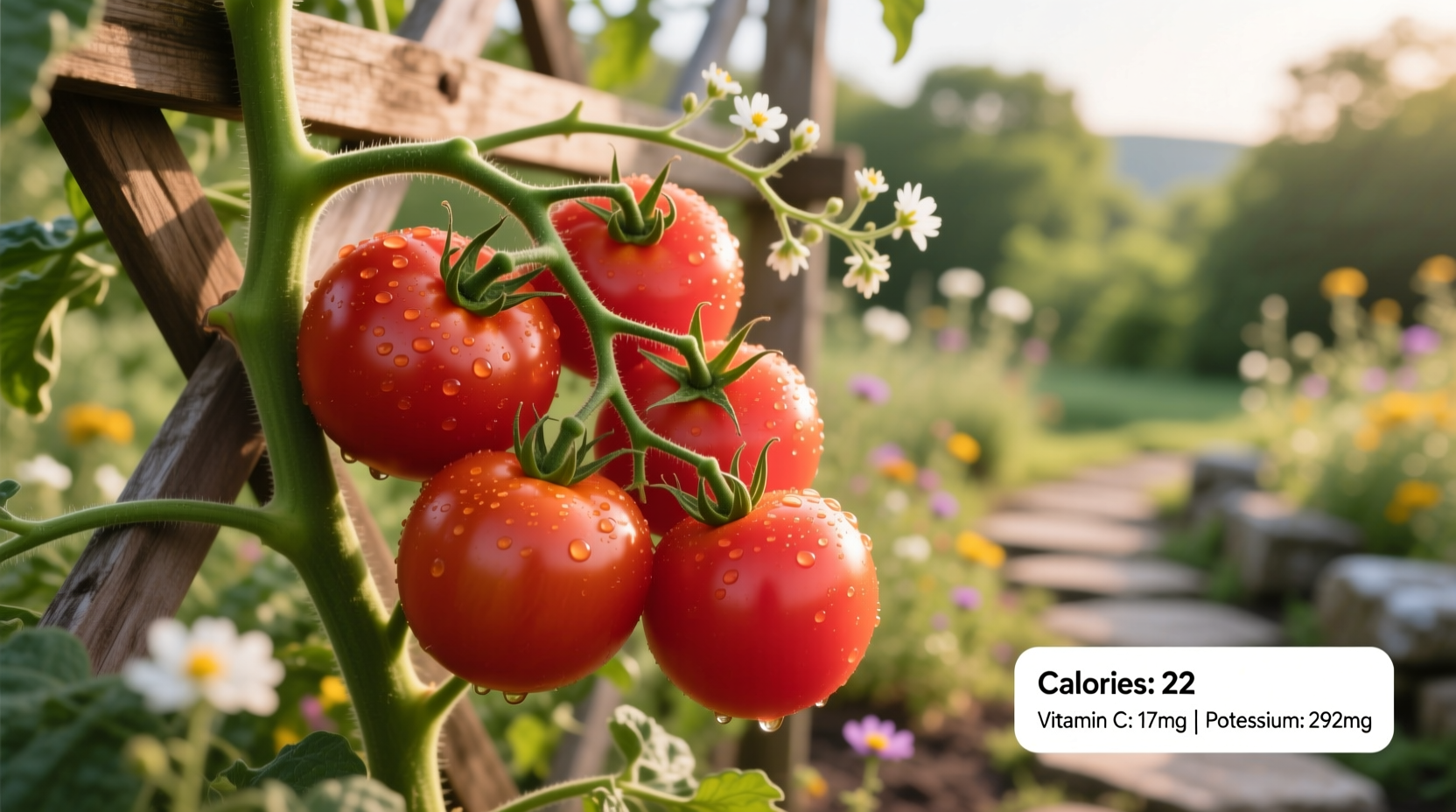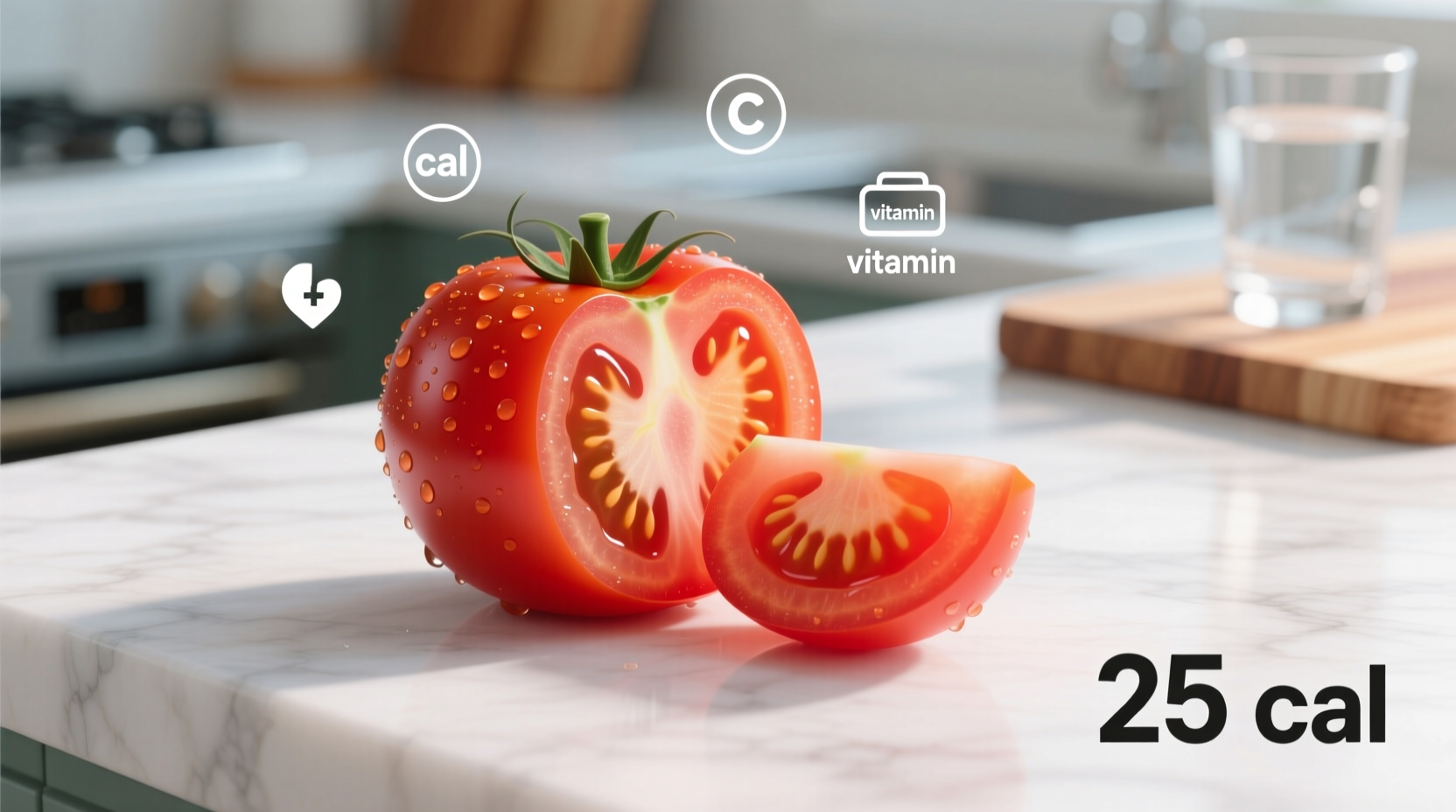Tomato Calorie Count: The Essential Facts
When you're tracking your daily calorie intake, knowing the precise nutritional value of common foods is essential. According to the USDA FoodData Central, the official source for nutritional information in the United States:
| Tomato Measurement | Calories | Carbohydrates | Protein | Fat |
|---|---|---|---|---|
| 100 grams (raw) | 18 kcal | 3.9 g | 0.9 g | 0.2 g |
| Medium tomato (123g) | 22 kcal | 4.8 g | 1.1 g | 0.2 g |
| Cherry tomato (5g) | 1 kcal | 0.2 g | 0.04 g | 0.01 g |
| 1 cup diced (180g) | 32 kcal | 7 g | 1.6 g | 0.4 g |
This nutritional profile explains why tomatoes consistently appear on lists of best low-calorie vegetables for weight loss. Their high water content (95%) and fiber contribute to satiety without adding significant calories to your daily intake.
Understanding Tomato Nutrition Beyond Calories
While the calorie count is important, tomatoes offer remarkable nutritional benefits that make them valuable for overall health. A medium tomato provides:
- Nearly 28% of your daily vitamin C needs
- About 20% of your recommended vitamin A intake
- Significant potassium (430mg per medium tomato)
- Powerful antioxidants like lycopene, which increases when tomatoes are cooked
- Only 5 grams of natural sugars
Unlike many low-calorie foods that lack nutritional density, tomatoes deliver substantial health benefits per calorie. Research from the National Institutes of Health shows that lycopene in tomatoes may reduce the risk of heart disease and certain cancers.

Factors That Affect Tomato Calorie Content
Not all tomatoes contain exactly the same number of calories. Several factors influence the precise nutritional profile:
Variety Differences
While most common varieties (Roma, Beefsteak, Vine-ripened) have similar calorie counts, some specialty tomatoes vary slightly:
- Cherry tomatoes: Slightly higher in sugar (about 5-6 calories per ounce)
- Heirloom tomatoes: Generally similar to standard varieties but can vary based on specific type
- Green tomatoes: Unripe tomatoes contain slightly less sugar and calories
Preparation Methods Matter
How you prepare tomatoes significantly impacts their calorie density:
- Raw tomatoes: Maintain lowest calorie count (18kcal per 100g)
- Cooked tomatoes: Calorie count remains similar, but volume reduces
- Sun-dried tomatoes: Concentrated form contains about 258kcal per 100g
- Tomato sauce: Approximately 40-70kcal per 100g depending on added ingredients
- Tomato juice: Around 18kcal per 100ml (check labels for added sugars)
When tracking calories for how many calories in a tomato for weight loss, remember that added ingredients like oil, sugar, or cheese dramatically increase the calorie content of tomato-based dishes.
Tomatoes in Your Daily Diet: Practical Applications
Understanding how many calories are in a tomato compared to other vegetables helps you make informed dietary choices. Here's how tomatoes stack up against common produce:
| Vegetable (100g) | Calories | Carbohydrates | Fiber |
|---|---|---|---|
| Tomato | 18 | 3.9g | 1.2g |
| Cucumber | 15 | 3.6g | 0.5g |
| Spinach (raw) | 23 | 3.6g | 2.2g |
| Carrot | 41 | 9.6g | 2.8g |
| Broccoli | 34 | 7.2g | 2.6g |
This comparison shows tomatoes sit comfortably among the lowest-calorie vegetables while providing unique nutritional benefits. For those following specific dietary patterns:
- Keto dieters: Tomatoes contain about 2-3g net carbs per 100g, making them acceptable in moderation
- Diabetics: Low glycemic index (15) means tomatoes have minimal impact on blood sugar
- Weight loss: Adding tomatoes to meals increases volume without significant calories, promoting fullness
Maximizing Tomato Benefits in Your Meals
To get the most nutritional value from tomatoes while maintaining their low-calorie advantage:
- Add raw tomatoes to salads instead of higher-calorie toppings
- Use tomato-based sauces as pizza or pasta bases instead of cream sauces
- Roast tomatoes with minimal oil to concentrate flavor without excessive calories
- Combine tomatoes with healthy fats (like olive oil or avocado) to boost lycopene absorption
- Choose vine-ripened tomatoes when possible for optimal nutrient content
Remember that how many calories does one tomato have depends on size and variety, but generally falls within the 15-25 calorie range for standard medium tomatoes. This makes them an incredibly versatile ingredient for health-conscious eating.
Frequently Asked Questions
How many calories in a medium tomato?
A medium-sized tomato (approximately 123 grams) contains 22 calories according to USDA FoodData Central. This makes tomatoes an excellent low-calorie food choice that provides significant nutritional value without adding substantial calories to your daily intake.
Do different tomato varieties have different calorie counts?
Most common tomato varieties (Roma, Beefsteak, Vine-ripened) have very similar calorie counts at about 18 calories per 100 grams. Cherry tomatoes are slightly higher in sugar content (about 5-6 calories per ounce), while sun-dried tomatoes are significantly more calorie-dense at approximately 258 calories per 100 grams due to water removal.
Are tomatoes good for weight loss?
Yes, tomatoes are excellent for weight loss due to their low calorie density (only 18 calories per 100g), high water content (95%), and fiber content. They provide volume and nutrients without adding significant calories, helping you feel full while maintaining a calorie deficit. Research shows that including high-water, low-calorie foods like tomatoes can support sustainable weight management.
Does cooking tomatoes change their calorie content?
Cooking tomatoes doesn't significantly change their calorie content per 100g, but it does concentrate the nutrients as water evaporates. For example, 100g of raw tomatoes contains 18 calories, while 100g of cooked tomatoes still contains approximately 18 calories, but represents more tomatoes due to reduced water content. Sun-dried tomatoes, however, contain about 258 calories per 100g because most of the water has been removed.
How many tomatoes can I eat on a 1,200-calorie diet?
On a 1,200-calorie diet, you could eat approximately 50-55 medium tomatoes (123g each) and stay within your calorie limit, though this isn't nutritionally balanced. In practice, tomatoes should be part of a varied diet. Most nutritionists recommend 1-2 medium tomatoes daily as part of a balanced eating pattern, providing valuable nutrients without excessive calories.











 浙公网安备
33010002000092号
浙公网安备
33010002000092号 浙B2-20120091-4
浙B2-20120091-4